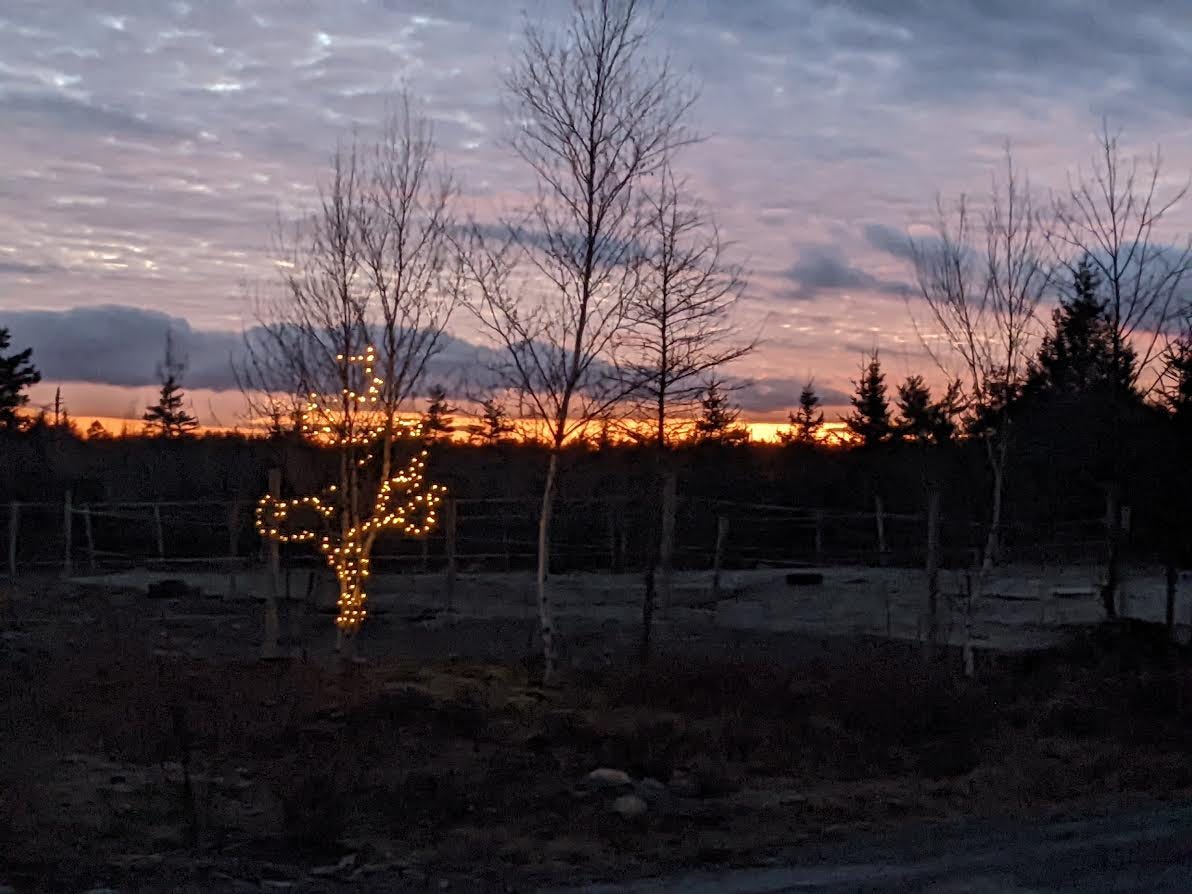Leaving the grid; and a trip to the Valley with a visit to The Rice Bowl
Solar lights at our property at sunset.
Leaving the grid is a subversive and revolutionary act.
It might not seem like it, but the banks don’t want you off the grid. Neither does the power company. The former won’t mortgage off-grid homes, and the latter does everything in its power to prevent people from leaving the grid.
It’s nothing personal. It’s just about the money.
A number of Canadian banks give lip service to sustainability, and achieving climate change goals while they continue to pump money into fossil fuels. A recent report titled Banking on Climate Chaos from a coalition of environmental groups show that among the top 12 banks financing fossil fuels globally since the Paris Agreement, 2016 to 2022 include The Royal Bank of Canada (RBC), ScotiaBank and TD. RBC has invested $253.9 billion in that amount of time.
Billions upon billions of dollars, and yet the banks can’t find the money to finance off-grid mortgages because the risk would be too big. What a joke.
For its part, RBC states in its annual climate report that 2030 is the target year for the bank to achieve its initial interim emissions reduction targets for lending in the oil and gas, power generation and automotive sectors.
Then, there’s the utilities. The utility companies don’t want people off-grid. It would cost them their monopolies on providing power.
It took the provincial government to pass a bill in April 2022 to prevent Nova Scotia Power from hampering the timely installation of solar projects. According to Solar Nova Scotia, the association for the provincial solar industry, the new legislation mandated that “residential and small business net metered customers who install a system up to 27 kilowatts will not be required to enter into a contractual agreement with Nova Scotia Power. By eliminating this red tape will result in much faster installations.
“Nova Scotia Power will no longer be able to impose a fee structure or system access charge that discourages customers from developing their own solar net metered energy systems.
“The 100-kilowatt Net Metering cap will be lifted enabling commercial, multi-unit residential and industrial sectors to install larger systems to offset their electricity costs.
“A new community solar program will open up solar access for all Nova Scotians wanting to reduce their power bills.”
In its release, Solar Nova Scotia quoted John Jennex, owner of Solar Ascent, who said, “Reducing the red tape and administration associated with Net Metering applications will definitely speed up the installation process. Currently it is taking several weeks and even months to receive approvals from Nova Scotia Power. Today’s announcement will eliminate this roadblock.”
This isn’t just propaganda from the solar industry. In making the amendments to the Electricity and Public Utilities Act, the province said that the promised legislative changes were being made to “protect solar homeowners and small businesses in the solar industry. Other amendments will push Nova Scotia Power to ensure that ratepayers have reliable, cleaner power and further hold the utility accountable for how it delivers electricity.”
Tory Rushton, Minister of Natural Resources and Renewables, said: “The amendments we’re introducing today support Nova Scotia ratepayers by empowering them to join our fight against climate change and adopt renewable sources of energy, and holding Nova Scotia Power to a higher standard of performance. Making changes in support of a thriving solar industry will help us in our goal of generating 80 per cent of our electricity through renewables by 2030.”
The government is to be applauded for such initiative and standing up to NSP.
So who would have thought that the act of building a more sustainable home could be subversive? But there you have it.
Municipalities aren’t all that invested in the idea either.
Off-grid does not have to mean an isolated dwelling in the country. District heating systems, for example, could be employed in cities.
A proven technology, “district heating is an underground infrastructure asset where thermal energy is provided to multiple buildings from a central energy plant or plants. Steam or hot water produced at the plant is transmitted 24/7 through highly insulated underground thermal piping networks. The thermal energy is transferred to the building’s heating system, avoiding the need for boilers in individual buildings,” according to the International District Heating Association.
The association notes that “This scale also enables integration of cleaner options like CHP, waste to energy, biomass, geothermal, and other renewables which significantly cut emissions unachievable on a building by building basis. District heating networks are useful energy infrastructure assets for cities, communities, and campuses.”
And yet next to no effort is made to introduce such renewable systems into civic infrastructure. Why? The answers could range from ignorance to the implications involved in leaving the grid - a lack of political will, in other words.
Whatever the reason, in a rapidly heating world such options should not only be on the table, but should be being acted upon as swiftly as possible. Every day brings more dire news about the impact of climate change upon the world. We are running out of choices, and time.
Not only should more people leave the grid, it is time for large numbers of more people to pass on coal, and other fossil fuel-generated power, in favour of renewables that cut down on harmful emissions and that might allow the planet to reduce some of the projected losses of biodiversity.
According to the Organisation for Economic Co-operation and Development, by 2050 without new climate policies in place, global terrestrial biodiversity will decrease by a further 10 percent by 2050; mature forest areas will shrink by 13 percent; and one-third of global freshwater biodiversity - which has already been lost - will continue to diminish to 2050.
While it’s true that corporate action on a large scale will likely make more of a difference, individual responsibility can help shift climate problems too. One thing that’s obvious is we can’t continue living in our current unsustainable fashion if we want to preserve the planet. Not everyone will leave the grid; not every one should have to, but the ongoing switch to renewables will also help cool our overheated Earth in the long run.
What’s local (Valley edition)
A couple of Mondays ago I ended up in the Annapolis Valley for a scheduled CT scan. If we didn’t live on the South Shore, I’d live in the valley. With its mountains, vineyards, cideries, fruit and vegetable stands and markets, and immaculately renovated farm houses it feels more like Sonoma, California than ever.
After my stop at the regional hospital, I headed over to the Maritime Express Cider Company in Kentville. Unfortunately, it was closed. Of course: Monday. Too bad, I’d been hoping to avail myself of some Roundhouse Rhubarb or perhaps some Derailed Sangria Cider. No such luck.
I pointed the car toward Wolfville and merged onto Highway 101. The sun beat down out of a bluebird sky. For April, it was a spectacular day. Along the way, I stopped at a couple of markets, but not a whole lot caught my attention, so I proceeded into Wolfville proper, stopping at the Annapolis Cider Company. There, I snagged a bottle of Northern Spy.
The cider company describes this particular beverage as “golden-hued with bright notes of fresh apple, this cider is a celebration of one of Nova Scotia's most prized cider apples.” It notes the Spy apple is a North American heirloom variety renowned for its sharp flavour and subtle sweetness. I say, it’s a fine tipple.
By this time, it was mid-afternoon, and I was getting peckish. In fact, I was downright hungry. Before driving to the valley I’d researched the restaurants and settled on The Rice Bowl. From what I’d read, The Rice Bowl specializes in food from Southeast Asia, particularly from Thailand, Viet Nam and Singapore. I was keen to try it.
The restaurant offers take out only, and is located in a large century home on Wolfville’s main strip. As I entered from the porch that was only slightly larger than the deck of a cruise ship, a bell sonorously sounded and a voice echoing through the house announced: “Front door!”
With a reception like that I was expecting front-of-the-house staff to swarm down in a mad rush to take my order. Instead: crickets.
Nothing.
Nada.
I stood in the entry hallway facing a half-door that opened onto a large and empty kitchen. I waited. And waited. And waited.
“Hello,” I called. “Anyone? Hello?”
My voice sounded small in the big house.
I waited some more.
Finally, I opened and closed the entry way door again.
The bell sounded. “Front door,” the voice announced.
I thought briefly of vaulting into the kitchen and cooking my own meal, but I was short on time. I’d promised a friend I’d drive over and see the new home he was building on top of one of the mountains. Within short order I was not only hungry, but now lost on the valley’s back roads. Things were turning dire.
Long story short, I did find my friend’s place, had a lovely visit, and then headed back to Wolfville, determined to find something to eat. Always a sucker for punishment, I returned to The Rice Bowl.
The Rice Bowl’s front porch in Wolfville.
Again, the door, the bell, the announcement. But lo and behold, a small, smiling woman appeared and asked what I’d like.
I placed my order, at which point she told me I’d have to wait 15 minutes. I was fine with that and indicated I’d hang out on the porch. I think I was worried if I went any further I might lose the window of opportunity for my food, and at this point I was desperately hungry.
Fifteen minutes, pretty much precisely, my food arrived. I’d hoped for sticky rice, but was told it wasn’t available today. My main order consisted of Tom Yam, a Thai hot and sour soup I had not had in at least five years, and which I dearly love. The Rice Bowl’s was loaded with shrimp and liberally seasoned with lemongrass, kaffir lime leaves, lime juice, fish sauce, and chili peppers.
The Tom Yam. Singularly delicious.
Was it worth the wait?
Let’s put it this way: It was the best Tom Yam I’ve ever had. Three-quarters of the way through I was seriously sweating from the heat. But heat isn’t the only criteria. The soup was flavourful and packed with fresh ingredients.
The Rice Bowl’s menu is large; I can hardly wait to dig deeper and explore the many other dishes on offer…even if it means returning twice in one day.
What I’m reading
As its title suggests, this slim novel encapsulates a whole life. In this instance, it is that of Andreas Eggers, who spends most of it in the Austrian Alps. By most measures, Eggers’ is not a happy life. He grows up in a cruel foster family, briefly finds true love once only to have it stolen away, and ends up as a prisoner-of-war in a Russian concentration camp for eight wars during World War II and beyond. After, he returns to the Alps, a lonely, half-mad old man. Maybe, though, it is like a lot of lives: unremittingly grim, and shot through here and there with moments of beauty and illumination.
What I’m listening to
Speaking of subversive, Jane Bunnett sneaks some fairly sly stuff into her charts. Ostensibly Latin jazz, all of a sudden her all-star band bursts into some definite Frank Zappa-era Peaches en Regalia-style quotes out of nowhere. Elsewhere, Bunnett has written a number that wouldn’t be out of place on a Weather Report album. This is one high-energy, big band outing for sure. Known for her explorations of Cuban jazz, soprano saxophonist Bunnett has been nominated multiple times for Grammy Awards and won Junos five times. On Rendez-vouz Brazil Cuba, Bunnett explores the two Latin styles with pianist Hilario Duran representing Cuba, among others; and percussionist Celso Machado standing in for Brazil, while his brother Filo Machado has written much of the material on this recording, plays guitar, and provides vocals.








Love reading your blog, but miss seeing your face and hearing your humour more. Here's an egg.
Hi Charles. I saw something on Nova PBS called Chasing Carbon Zero . It was actually hopeful. But maybe there were a lot less regulations where these examples were taken.
https://www.pbs.org/video/chasing-carbon-zero-mzijvs/
This might work if have PBS Passport , but even some of their stuff isn't licensed to stream in Cana da